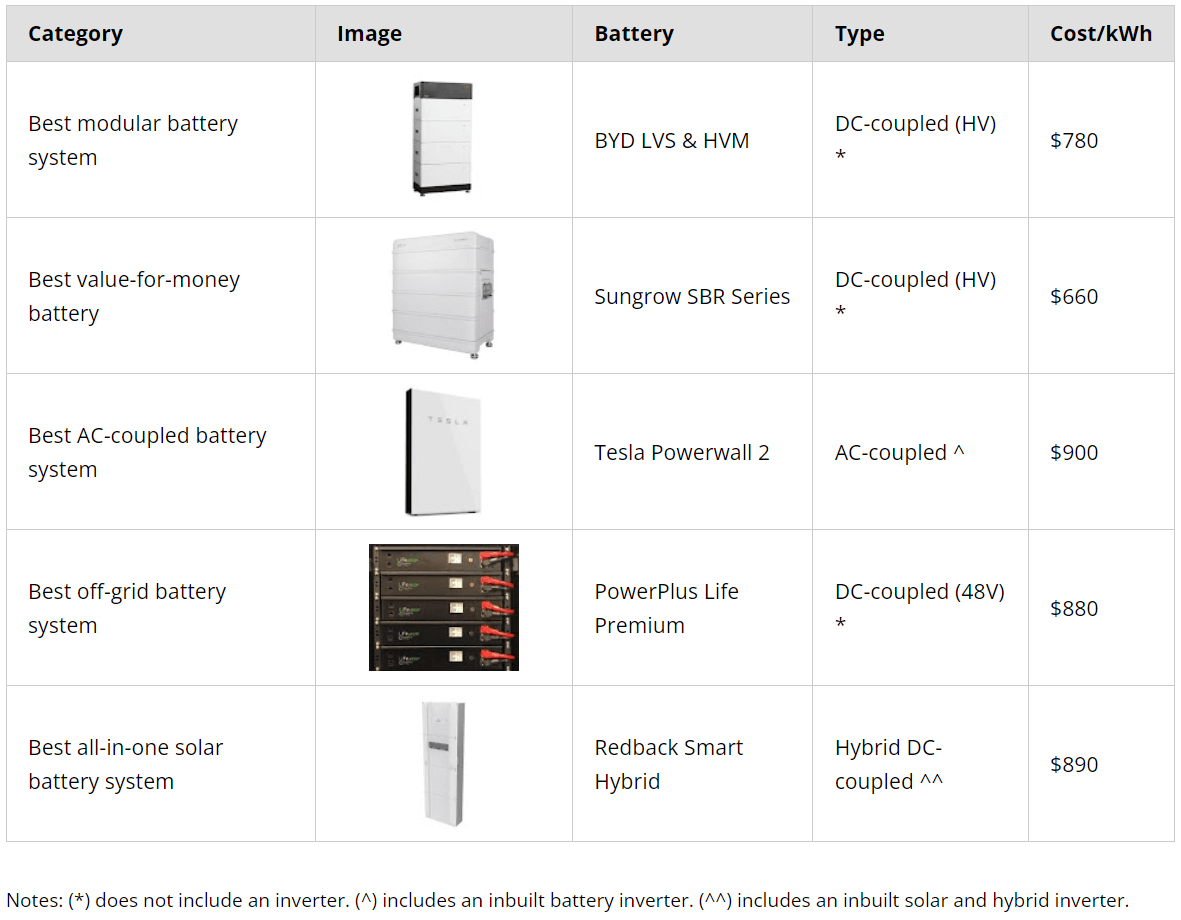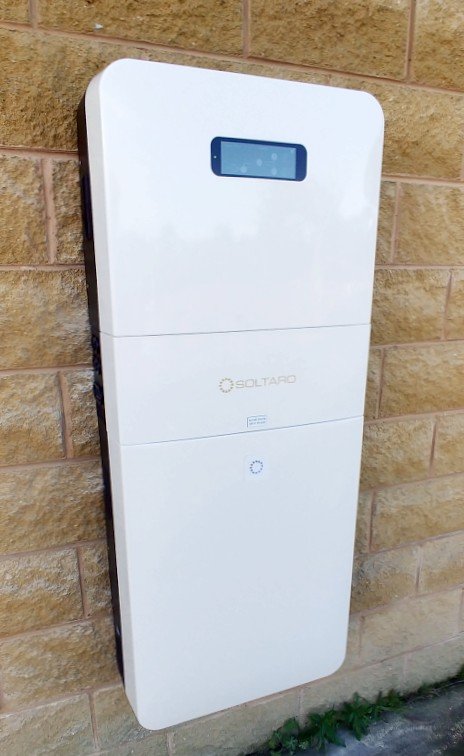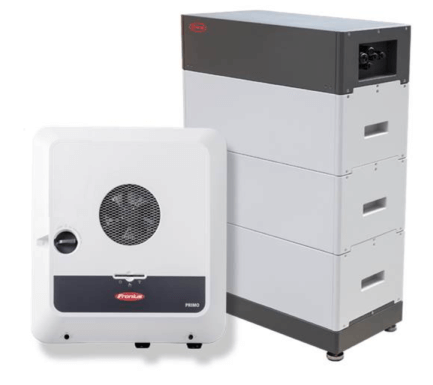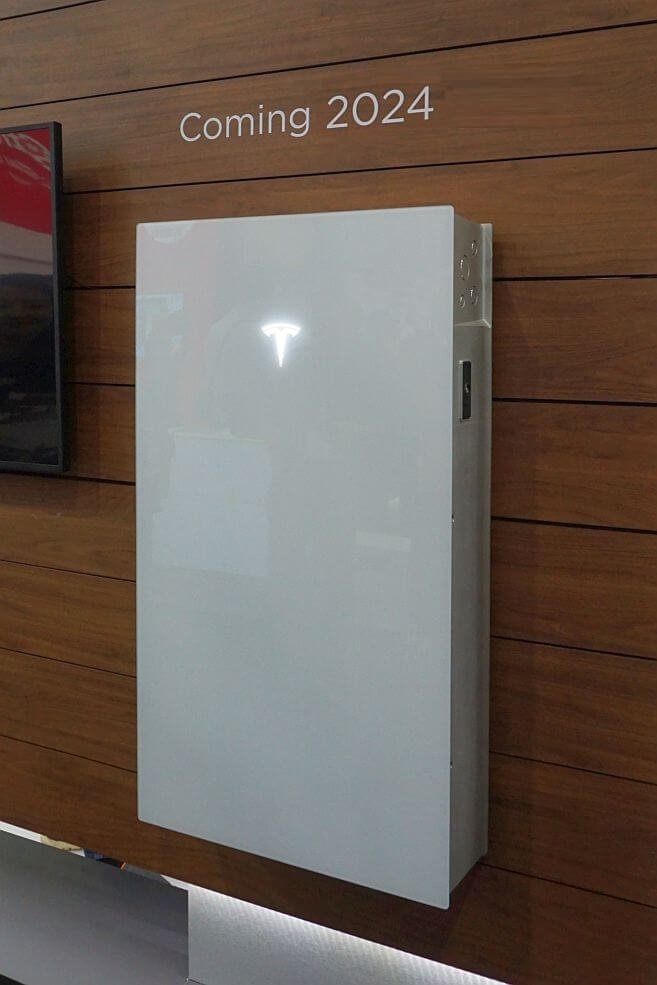Best Home Solar Battery Systems
November 2023 - Australian Edition
Home storage batteries have been on the market for many years, with numerous varieties and sizes available. This review highlights the leading batteries available for various household and off-grid solar systems. For those new to solar, see our introduction to battery storage, including the pros and cons of home batteries. Also, see our introduction to different types of solar systems, including grid-tie, off-grid and hybrid systems.
Best home solar battery systems 2023 : BYD HVM series, Tesla Powerwall, Powerplus LiFe, Sungrow SBR, Redback Tech.
Best Solar Battery Comparison Chart
Battery capacity explained
Battery size or capacity is measured in kWh (kilowatt-hours). This is the total amount of energy a battery can store. However, the usable capacity may differ from the total battery capacity. Generally, the usable capacity is limited to 80 to 90% of the total battery capacity to increase the lifespan and avoid a potential battery shutdown at very low charge levels. For example, a lithium battery with a 10kWh total capacity may have its usable capacity limited to 80% to increase its lifespan. Therefore, 8kWh of energy can be discharged daily. However, the remaining 10 to 20% is often available in emergencies, such as a prolonged blackout, depending on how the system is programmed.
The solar and battery calculator will help you determine the correct size solar and battery for your home.
What size battery do I need?
Unfortunately, the one-size-fits-all approach is often taken when it comes to sizing a battery, which can lead to poor performance and not meeting the consumer’s expectations. This is typically due to two main reasons: Undersized batteries - do not have enough capacity to meet household demand. Oversized batteries - the solar array doesn’t have sufficient power to charge the battery, typically during the winter months.
To avoid these issues, a battery should be selected and sized according to several important factors, including solar array size (existing or new), system type (on-grid or off-grid), backup power requirements, and most importantly, the evening or overnight energy consumption (kWh). You can use our free solar and battery sizing tool to help determine the correct size battery for your needs. Fortunately, most modern battery systems are modular and scalable so that they can be sized accordingly. With this in mind, we selected the best batteries according to the six following categories:
Battery comparison criteria
Selecting the best battery is difficult due to the many system types or configurations available, each with different performance characteristics. Another layer of complexity is the compatibility issue - many lithium batteries are designed to work with a specific type of hybrid inverter. For example, high-voltage or HV batteries can only be used with an HV-compatible hybrid inverter, while others, such as the Tesla Powerwall 2, are AC-coupled batteries utilising inbuilt inverters which enable them to be retrofitted to a home with an existing solar system. Then, there are modular, rack-mount battery systems designed to work with powerful off-grid battery inverter-chargers.
With this in mind, selecting the best battery is not straightforward as all battery systems need to be judged on a range of criteria, including:
Usable storage capacity (kWh) and modularity
Output power ratings - Continous and peak
Efficiency - charge & discharge losses
Cost - Battery upfront cost
Cycle life - capacity loss over time
Inverter compatibility
Manufacturers warranty conditions
This might sound overwhelming, but luckily, we have done the hard work for you by performing our own comprehensive testing and gathering feedback from many experienced solar professionals to determine the best battery for each application.
Battery cost comparison
Home battery storage costs vary widely depending on the brand and battery capacity (kWh), costing between $650 and $1100 per kWh installed. For example, a typical 10kWh home battery, excluding inverter, will cost around $7500, plus installation. While an AC-coupled battery, such as the 13.5kWh Tesla Powerwall 2, will cost around $13,000, plus installation.
A complete rooftop solar and battery installation, including a 10kWh battery, compatible hybrid inverter and an 8 to 10kW solar array, would typically cost between $16,000 and $25,000, depending on the inverter size, solar panel brand and complexity. Battery prices vary significantly in different countries depending on the exchange rate. Australia is lucky to be one of the world leaders in home battery installations and has access to a wide variety of affordable batteries from Asia, plus high-end battery systems from Europe and the US.
For a detailed comparison of the upfront and operational costs of various lithium home batteries, see the in-depth analysis of the leading lithium battery systems in the detailed home battery storage review.
Best Modular Battery System
BYD Premium LVS & HVM
BYD is now the world's third-largest battery manufacturer and one of the leading innovators in lithium battery technology. The Chinese company, first established in 1995, makes Lithium battery systems using LFP (lithium iron phosphate) cells due to the increased safety, stability and lifespan compared to other lithium chemistries. BYD pioneered the modular tower battery concept, with the first generation stackable system launched in 2017, and now boasts a range of modular batteries for high (HV) and low-voltage (LV) systems.
BYD LVS and HVM Battery specifications
Type: DC battery system
Chemistry: Lithium LFP prismatic cells
Capacity: LVS = 4.0kWh per module up to 256kWh, HVM = 2.76kWh per module up to 66kWh
Power: LVS = 3.3kW per module, HVM = 5kW per module
Cycle life: up to 8000 cycles (claimed)
Price: LVS = $760 per kWh (US$530), HVM = $810 per kWh (US$580)
Warranty: 10 years to 60% minimum retained capacity.
Compatibility: Fronius, Selectronic, SMA, Victron, Sungrow, Goodwe, Solis.
The Fronius GEN24 inverter and BYD HVM are an excellent combination for residential energy storage.
BYD HMV Battery Score
Compatibility - 8/10
Modularity - 10/10
Cycle Life - 8.5/10
Warranty - 7.5/10
Cost - 7.5/10
The LVS Premium series is a low-voltage (LV) 48V modular tower battery system designed to cater for different energy storage requirements. The LV tower system uses a battery monitoring unit (BMU) to manage and control each 4.0kWh module. Usable capacity is 100%, and up to 6 modules can be installed per tower for a total of 24kWh. For greater storage capacity, multiple towers of 4 modules can be linked together with a maximum of 16 towers, or 256kWh. Note, while the usable capacity is listed at 100%, the real-world capacity will be lower due to common inverter voltage limitations and inbuilt protection to prevent black-start events, which often occur when the battery is drained below 10% state of charge. The BYD Premium LVL series has a much larger 15.4kWh capacity and is designed for larger off-grid, grid-tie and even off-grid energy storage applications. While not technically stackable, it is modular and scalable up to an impressive 983kWh, close to 1.0GWh. The BYD high voltage (HV) batteries are available in two voltage options (HVM and HVS) for different energy storage requirements, depending on which hybrid inverter is used. A popular combination, shown above, is the Fronius GEN24 inverter and BYD HVM battery. Learn more in the detailed BYD battery review.
Runner up
Pylontech US Series Batteries
Another popular low-voltage (LV) battery system is the well-known US series from Pylontech or Pylon Technologies. The US3000 lithium (LFP) 3.55kWh battery modules have been around for many years and performed exceptionally well in the ITP renewables battery test program. They are also among the best-value batteries on the market, as highlighted in our battery cost guide.
Best Value-For-Money Battery System
Sungrow SBR Battery
Sungrow was founded by Cao Renxian, a professor at Hefei University of Technology, driven by a vision to enhance electricity access in rural western China through renewable energy sources. This commitment to advancing renewable energy access laid the cornerstone for one of the most successful inverter companies globally. Today, Sungrow Power Supply Co. Ltd is one of the world's largest inverter manufacturers, boasting a remarkable net worth of $1.5 billion. Specializing in research and development, manufacturing, and service provision for power supply systems in areas such as wind energy, battery storage and conversion, electric vehicles, and solar PV power systems, Sungrow has carved its niche in the industry.
Sungrow SBR Battery specifications
Type: DC-coupled battery (High Voltage)
Chemistry: Lithium LFP cells
Capacity: min 3 modules or 9.6kWh with 100% usable capacity
Power output: 5.7kW continuous, 6.6kW peak (with the min 3 modules)
Cycle life: approx 4000 cycles (claimed) - Ref warranty doc
Price: $6400 for 9.6kWh or approx $660 per kWh
Warranty: 10 years to 70% minimum retained capacity.
Compatibility: Any solar inverter (AC-coupled)
Sungrow SBR Battery Score
Compatibility - 5/10
Modularity - 9/10
Cycle Life - 8/10
Warranty - 8.5/10
Cost - 9.5/10
The recently released high-voltage Sungrow SBR battery system has gained a lot of attention due to the highly competitive pricing and compatibility with the powerful Sungrow SH-RT hybrid inverters. The SBR system is scalable and efficient thanks to the lower conversion losses achievable at higher voltages. Each module has a 3.2kWh capacity, and they stack together on a base unit with a BMS head unit that is used as a communication hub to the inverter. One clever feature is the slide-in DC isolator, eliminating the need for an external DC isolator. The battery modules are built using Lithium Ferro Phosphate (LFP) cells, which are generally considered the safest and longest-lasting battery chemistry. LFP cells contain no Cobalt, meaning they are more sustainable and do not involve controversial mining activities, unlike lithium MNC cells used by other manufacturers.
Runner up
Goodwe Lynx U-series
The Goodwe Lynx battery system boasts a range of innovative features, including remote monitoring and software upgrades, plus the ability to identify additional parallel modules automatically, making setup effortless. While output power is limited to 2.5kW continuously using one battery, the power rating is increased to 5.76kW with two or more batteries in parallel. Learn more in our detailed Goodwe Inverter and battery review.
Best AC-Coupled Battery System
Tesla Powerwall 2
The first Tesla Powerwall is widely known as the battery that kick-started the home energy storage revolution. However, it wasn’t until the Tesla Powerwall 2 was released in early 2017 that it hit the mainstream. The Powerwall 2 is more expensive than most at AU$ 14,000 or US$ 10,000, plus installation. However, unlike the other batteries listed, the Powerwall 2 is an AC-coupled battery system, meaning it contains an integrated inverter-charger and can be retrofitted to any home with an existing solar installation. Although, it still requires a solar inverter to function with solar. Furthermore, the additional Tesla gateway box is required to enable backup power in the event of a blackout, which adds around $1,800 to the price but enables many useful ‘smart’ features, advanced controls and monitoring.
Tesla Powerwall Battery specifications
Type: AC battery system
Chemistry: Lithium NMC cells
Capacity: 13.5kWh with 90% usable capacity
Power output: 5kW continuous, 7kW peak
Cycle life: approx 3600 cycles or 10 years (claimed) - Ref warranty doc
Price: AU$12,200 + backup gateway = $920 per kWh (US$620)
Warranty: 10 years to 70% minimum retained capacity.
Compatibility: Any solar inverter (AC-coupled)
Tesla Powerwall 2 Score
Compatibility - 10/10
Modularity - 7/10
Cycle Life - 8/10
Warranty - 8.5/10
Cost - 7.5/10
The Powerwall 2 uses high-quality lithium nickel-manganese-cobalt (NMC) cells developed in collaboration with Panasonic. It also features a clever liquid thermal cooling system, making it one of the most advanced stationary battery systems in the world. The liquid-cooling allows a wide operating temperature range (-20 to 50 degC), meaning it is less likely to derate (reduce output) in high ambient temperatures and extremely low temperatures. Furthermore, it has a high weather rating (IP56), meaning it can safely be installed outside. The Powerwall 2 can also work in parallel with up to 9 units (3 per phase) for homes/businesses with greater energy storage requirements. Learn more in the detailed Tesla Powerwall review.
Runner up
FranklinWH and SunPower battery systems
FranklinWH is a relatively new player in the home energy storage market and has surged in popularity due to the high backup power rating and generator input, making it more suitable for prolonged power outages. The SunPower SunVault system is also a close contender, being a similar size to both the Tesla Powerwall and FranklinWH at 13kWh and built around a very reliable, high-performance Schnider XW Pro inverter offering up to an impressive 12kW surge power rating. In other parts of the world, there are several other high-quality AC battery systems, including the well-known Sonnen ECO system, which is manufactured in Australia and Germany, and the Senec Home system, which is also manufactured in Germany.
Best Off-Grid Battery System
PowerPlus Energy LiFe Premium
Based on direct experience and feedback from many professional off-grid designers and installers, the self-managed lithium batteries from Powerplus Energy in Melbourne, Australia, stood out as the best and most reliable choice for off-grid solar systems. Unlike the many common managed** lithium battery systems on the market from manufacturers such as BYD and Pylontech, self-managed lithium battery systems do not require a communication connection (CAN-bus) with the inverter and are compatible with almost all leading off-grid inverter-chargers. These batteries can be used as a drop-in replacement for older lead-acid battery banks. We should also note in certain situations, self-managed battery modules can be ‘hot-swapped’ or replaced without shutting the down site if there is an issue.
** Managed lithium battery systems are generally very reliable, but they can be problematic, especially at a low state of charge (SOC) and very low temperatures. However, managed batteries provide a higher monitoring level at the module and cell level.
Powerplus Energy Battery specifications
Type: DC battery system (self-managed)
Chemistry: Lithium (LFP) cells
Capacity: 3.3kWh with 100% usable capacity (80% DoD for warranty)
Power output: 3kW continuous, 3.3kW peak (per 48V module)
Cycle life: 3500 to 5000 cycles (based on DoD)
Price: approx $3,000 = $880 per kWh (US$610)
Warranty: 10 years to 70% minimum retained capacity.
Compatibility: Most 24V, 48V, or 120V off-grid or hybrid inverters
PowerPlus Energy Score
Compatibility - 9/10
Modularity - 10/10
Cycle Life - 8/10
Warranty - 8.5/10
Cost - 7/10
The modular lithium batteries from Powerplus Energy feature high-performance lithium Ferro phosphate (LFP) cells, widely known as the longest-lasting and most stable battery chemistry, backed by a 10-year warranty from a local, reputable manufacturer. Being Australian-based with relatively low volumes, they are not yet widely available. However, production volume is increasing with the larger manufacturing facility now in operation. Powerplus Energy also offers a more affordable ECO 4kWh battery option.
Other reliable off-grid battery options
Due to limited supply, not all countries can access Powerplus Energy batteries. However, there are several other trusted high-performance, self-managed lithium batteries available. In North America, the Simpliphi PHI and Discover AES batteries are very well regarded, while GenZ and the unique long-life Zenaji Aeon lithium titanate batteries are other options available in Asia and Australia. Learn more about off-grid batteries in the off-grid solar system review.
Best All-In-One System - BESS
Redback Tech Smart Hybrid
Redback Technologies is an Australian company focused on developing smart, integrated, hybrid energy storage systems for homes and businesses. The first generation smart hybrid system was released back in early 2016, while the Gen 2 system was introduced in 2018. Redback teamed up with the University of Queensland and the well-established Chinese inverter manufacturer Goodwe to deliver a quality, feature-packed energy storage system at an affordable price.
Redback Battery specifications
Type: All-in-one BESS - Pylontech batteries inside
Chemistry: Lithium LFP
Capacity: 11.4kWh with 80% usable capacity (20% reserve)
Power output: 5kW continuous, 7.5kW peak
Cycle life: approx 4000 cycles (claimed) - Ref warranty doc
Price: approx $10,500 = $920 per kWh (US$675)
Warranty: 10 years to 60% minimum retained capacity.
Redback Hybrid Score
Compatibility - N/A
Modularity - 6/10
Cycle Life - 8/10
Warranty - 8/10
Cost - 8/10 (includes solar inverter)
The system is built on the well-known Goodwe ES hybrid architecture. It features a high (40A) pass-through power capability, which, unlike most other hybrid inverters, enables the Redback system to handle higher loads in both on and off-grid modes. The system functions much like a UPS with instantaneous backup and is able to operate in off-grid mode indefinitely (with adequate solar). The Redback system also includes inbuilt smart controls (relays) to turn on loads or appliances based on various settings. One of the clever cloud-based features is the remote access to configuration/settings, which makes life easier for installers and customers alike. The only downfall is that most systems need to be hardwired to a modem as the wifi has proven to be unreliable in specific locations. The Redback system is now available in a larger, more powerful 3-phase configuration for 3-phase homes and businesses.
Battery storage is integrated into the sleek weather-rated cabinet and can house up to 4 of the well-proven PylonTech LFP battery modules, enabling up to 11.4kWh of total storage capacity (9.2kWh usable capacity at 80% DOD). The PylonTech LFP batteries are some of the best-performing batteries in the ongoing tests conducted at the independent ITP renewables battery test centre.
Runner up
Other quality BESS systems
There are several other very good all-in-one BESS systems, including the new Soltaro AIO2 system and the AlphaESS Smile series. We should also mention the German-made Senec V3 hybrid system, which is a very popular choice in Europe.
Battery life and degradation explained.
Home energy storage battery systems have only been widely available for around eight years, so real-world performance and degradation data is still incomplete. However, data gathered so far via the testing and monitoring various (lithium) home battery systems suggests an 8 to 15+ year lifespan. The life of a battery is generally determined by either the number of charge and discharge cycles, or total energy throughput (kWh). All batteries lose capacity over time, with the end-of-life generally after a lithium battery has lost around 30% of its original capacity; based on the data gathered and the manufacturer’s warranty specifications, this will generally occur after ten years. However, lithium battery cell technology is constantly advancing, and some batteries, such as the Lithium Titanate (LTO) variety from Zenaji, are designed to last well over 20 years.
ITP battery test centre results showing battery degradation over time - Image credit ITP renewables
ITP Renewables, based in Canberra, Australia, has conducted battery performance tests since 2016. The accelerated testing program is performed in a variable climate-controlled lab to simulate real-world conditions and has produced some fascinating results, with only two battery systems (Sony and PylonTech) passing all tests without failure or premature degradation. Lithium cell degradation is dependent on a number of factors, including temperature, depth of discharge, and rate of charge. Based on the currently available data from ITP, battery end-of-life is estimated to be 3000 to 4500 cycles or 9 to 12 years. See our detailed Home Battery Storage Guide for more detailed analysis.














